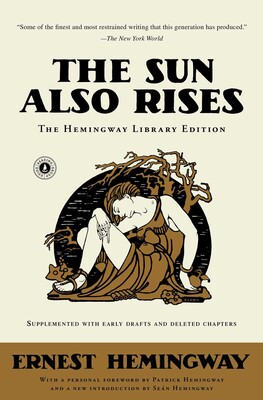The Sun Also Rises
The Hemingway Library Edition
LIST PRICE $18.00
Free shipping when you spend $40. Terms apply.
Buy from Other Retailers
Table of Contents
About The Book
“The ideal companion for troubled times: equal parts Continental escape and serious grappling with the question of what it means to be, and feel, lost.” —The Wall Street Journal
The Sun Also Rises is a classic example of Hemingway’s spare but powerful writing style. It celebrates the art and craft of Hemingway’s quintessential story of the Lost Generation—presented by the Hemingway family with illuminating supplementary material from the Hemingway Collection at the John F. Kennedy Library.
A poignant look at the disillusionment and angst of the post-World War I generation, the novel introduces two of Hemingway’s most unforgettable characters: Jake Barnes and Lady Brett Ashley. The story follows the flamboyant Brett and the hapless Jake as they journey from the wild nightlife of 1920s Paris to the brutal bullfighting rings of Spain with a motley group of expatriates. It is an age of moral bankruptcy, spiritual dissolution, unrealized love, and vanishing illusions. First published in 1926, The Sun Also Rises is “an absorbing, beautifully and tenderly absurd, heartbreaking narrative...a truly gripping story, told in lean, hard, athletic prose” (The New York Times).
The Hemingway Library Edition commemorates Hemingway’s classic novel with a personal foreword by Patrick Hemingway, the author’s sole surviving son, and an introduction by Sean Hemingway, grandson of the author. Hemingway considered the extensive rewriting that he did to shape his first novel the most difficult job of his life. Early drafts, deleted passages, and possible titles included in this new edition elucidate how the author achieved his first great literary masterpiece.
Reading Group Guide
Topics and Questions for Discussion
1. Consider the novel’s first epigraph: “You are all a lost generation.” How do the characters in the novel seem lost? What can you extrapolate about the Lost Generation from Hemingway’s portrait?
2. The characters in The Sun Also Rises were based on people in Hemingway’s life. What responsibility does an author have—if any—when drawing inspiration from real people? How do you think relationships and life experiences inform the creative process?
3. Why do you think this novel is one of Hemingway’s most enduring works? What about the story continues to resonate with readers? In what ways does the novel still feel contemporary?
4. Consider Jake’s fishing trip to the Irati River. How is the natural world depicted in the novel? How does it echo and refract the larger themes of the book?
5. On page 9, Jake says: “Nobody ever lives their life all the way up except bull-fighters.” How does the novel depict bullfighting from both an aesthetic and philosophical perspective? How does Hemingway’s depiction of bullfighting function as social commentary?
6. Throughout the novel, Jake’s war injury is alluded to but never described directly. Why do you think Hemingway made this narrative choice?
7. Jake and Brett are both haunted by the atrocities of war. How do their coping mechanisms differ? In what ways do their survival strategies overlap?
8. When we first meet Brett at the dancing club (page 17), we see that she is “very much with” a group of men. How does Brett upend traditional gender roles?
9. The guiding principle of Hemingway’s writing was the “iceberg theory” or the “theory of omission,” in which deeper meaning is not stated explicitly but exists beneath the surface. How is Hemingway’s iceberg theory on display in this novel? Were there any omitted moments that you wish had been included?
10. Is The Sun Also Rises a tale of unrequited love? What does the novel have to say about the relationship between sex and intimacy?
11. On page 169, just before Pedro Romero’s bullfight, Brett says, “Funny . . . how one doesn’t mind the blood.” Why is Brett the perfect muse for Romero? What does the novel have to say about our cultural attitudes toward violence?
12. What do you make of the final scene? What glimmers of hope beckon within Jake’s and Brett’s revelations?
13. Why do you think Hemingway chose the title The Sun Also Rises?
Enhance Your Book Club
1. Read Hemingway’s short story “A Clean Well-Lighted Place.” Do you see any thematic overlap? Why is the café milieu so important to Hemingway?
2. Watch Ken Burns’s documentary miniseries Ernest Hemingway. How does learning more about his life and hearing from other novelists inform your impression of Hemingway?
3. Brett Ashley, like Daisy Buchanan in The Great Gatsby, embodies the flapper aesthetic. Read The Great Gatsby and talk about how Hemingway and Fitzgerald depict women of the era.
Product Details
- Publisher: Scribner (February 16, 2016)
- Length: 320 pages
- ISBN13: 9781501121968
Raves and Reviews
"Some of the finest and most restrained writing that this generation has produced."
-- New York World
"An absorbing, beautifully and tenderly absurd, heart-breaking narrative...It is a truly gripping story, told in lean, hard athletic prose...magnificent."
-- The New York Times
“An elegy for the loss of innocence, of religion, of our old comforting myths... While every generation has its novel about dissipated young people drinking and drugging, the reason this book has survived is that it is a fundamentally philosophical work.”
– Philipp Meyer, New York Times bestselling author of THE SON
"The ideal companion for troubled times: equal parts Continental escape and serious grappling with the question of what it means to be, and feel, lost." --Tara Isabella Burton, The Wall Street Journal
Resources and Downloads
High Resolution Images
- Book Cover Image (jpg): The Sun Also Rises Trade Paperback 9781501121968
- Author Photo (jpg): Ernest Hemingway Earl Theisen, 1953(0.5 MB)
Any use of an author photo must include its respective photo credit












![Farewell to Arms [Chinese] Farewell to Arms [Chinese]](https://d28hgpri8am2if.cloudfront.net/book_images/onix/cvr9781451699845/farewell-to-arms-chinese-9781451699845.jpg)
![Old Man and the Sea [Chinese] Old Man and the Sea [Chinese]](https://d28hgpri8am2if.cloudfront.net/book_images/onix/cvr9781451699821/old-man-and-the-sea-chinese-9781451699821.jpg)


